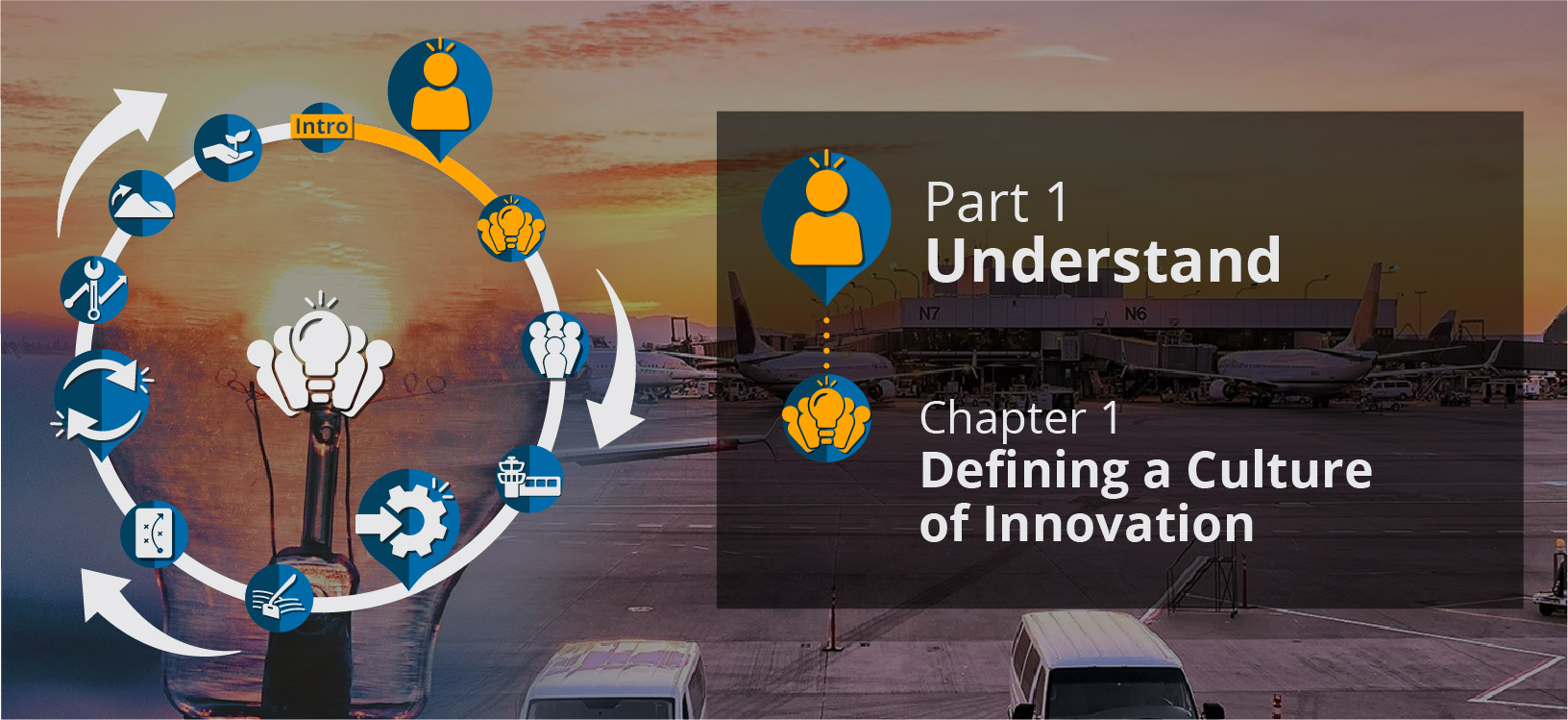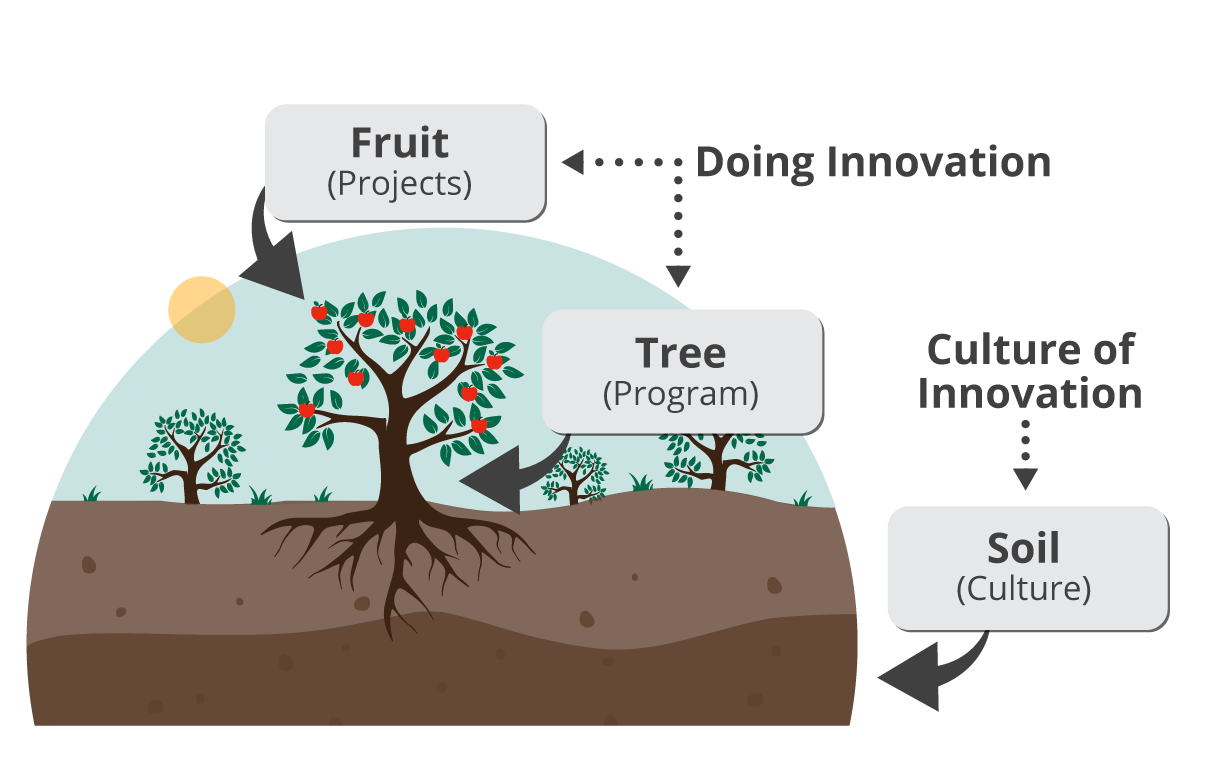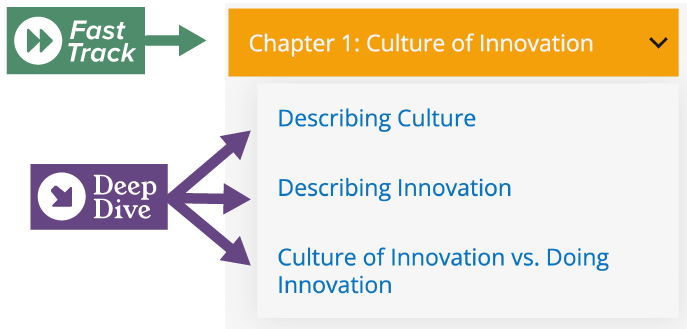

This is a Deep Dive page. Select the chapter for the Fast Track
Understanding a Culture of Innovation vs. Doing Innovation
As the research team gathered perspectives from aviation professionals across a wide range of focus areas and levels in their organizations, it became clear that there is a strong need to categorize the conversation surrounding “innovation.” The team was considering metaphors ranging from the engine of a race car to the growth of a tree when they came across an illustration created by Ed Essey of Microsoft Garage. This illustration presented three major ways that organizations view innovation: as fruit, a tree, or soil. In this metaphor, fruit = projects, a tree = a program, and soil = culture.1
This succinctly summarized the research team's findings and led to the creation of Figure D1.3, which illustrates these three major viewpoints. The team further applied the concept that the first two viewpoints focus on “doing innovation” while the third focuses on developing a culture of innovation.

Figure D1.3: Viewpoints of Innovation.
Fruit/projects viewpoint: In this example, innovation is seen as doing projects. These projects represent the eye-catching “fruit” that tangibly demonstrates to both internal and external stakeholders why innovation is needed and, in many cases, they are what sparks the need for innovation.
Airports that fall into this group are usually the first ones to test things or are early adopters of progressive solutions. For example, one airport case study participant noted that their first step with innovation targeted the long TSA checkpoint lines experienced by their customers. By implementing an innovative technological application (project/fruit), they were able to reduce the wait times and improve the customer experience. Their experience with demonstrating a tangible innovation enabled them to pursue additional innovative initiatives.
Tree/program viewpoint: In this second example, innovation is seen as having an innovation program. This can otherwise be known as a “plant a tree” scenario. These types of programs usually get their start when new executive positions (such as vice presidents of strategy or chief innovation officers) are added to an airport's organization chart. The programs focus on specific teams of people that help with ideating and carrying out innovative projects to address drivers and triggers of innovation (see previous sections in this chapter). Further, in some organizations, the special innovation team only focuses on projects considered to be transformative innovations and leaves any incremental or sustaining projects to the rest of the organization. This team is only focused on innovations that are at least three to five years out.
Soil/culture of innovation viewpoint: In this third example, airports see innovation as the “soil,” which in turn becomes part of the organization's culture. In this scenario, unlike the other two, innovation becomes a continuous cycle in which the soil is continuously nourished. As a result, the organization can plant more trees (programs) and bear more fruit (projects) as part of its cultural norm. It is an expansion from doing innovation to being innovative, which inevitably leads to doing more innovation. However, achieving this cultural viewpoint does typically require seeing evidence of fruit growing before major shifts in mindset and behaviors can be made. This evidence can be used to demonstrate the value and benefits of a culture that can continue to bear this type of fruit.
And just as the soil in a garden needs to be cultivated to remove weeds and add nutrients, so does the airport's culture. As barriers to creativity and experimentation are removed from the culture, inclusive collaboration and problem-solving can be added in. The culture may then begin to feed the organization with new ideas for improving daily business processes through incremental innovation and ways to adapt to the challenges and opportunities facing the aviation industry through sustaining innovation.
What Does the Culture of Innovation look like?
A culture of innovation is a holistic workplace culture that encourages free thinking; an experimental approach to creating solutions; and a willingness to learn to generate new or improved products, services, or processes. It brings diverse perspectives to the table and promotes a sense of belonging for all staff members where everyone feels their voice is welcomed and heard. It promotes and fosters a work environment in which everyone knows that their individual roles are changing the organization for the better, no matter their job function. Achieving this requires understanding the things that shape the norms, values, and behaviors carried out by individuals in an organization. It also entails developing characteristics-such as leadership behavior, organizational structure, business processes, metrics, incentives, rewards, recognition, and symbols-that reinforce innovation.


1 Ed Essey, “How to Unlock Your Innovation Growth with Fruits, Trees, and Soil,” Edessey.com, July 31, 2018, https://edessey.com/fruits-trees-and-soil/.

